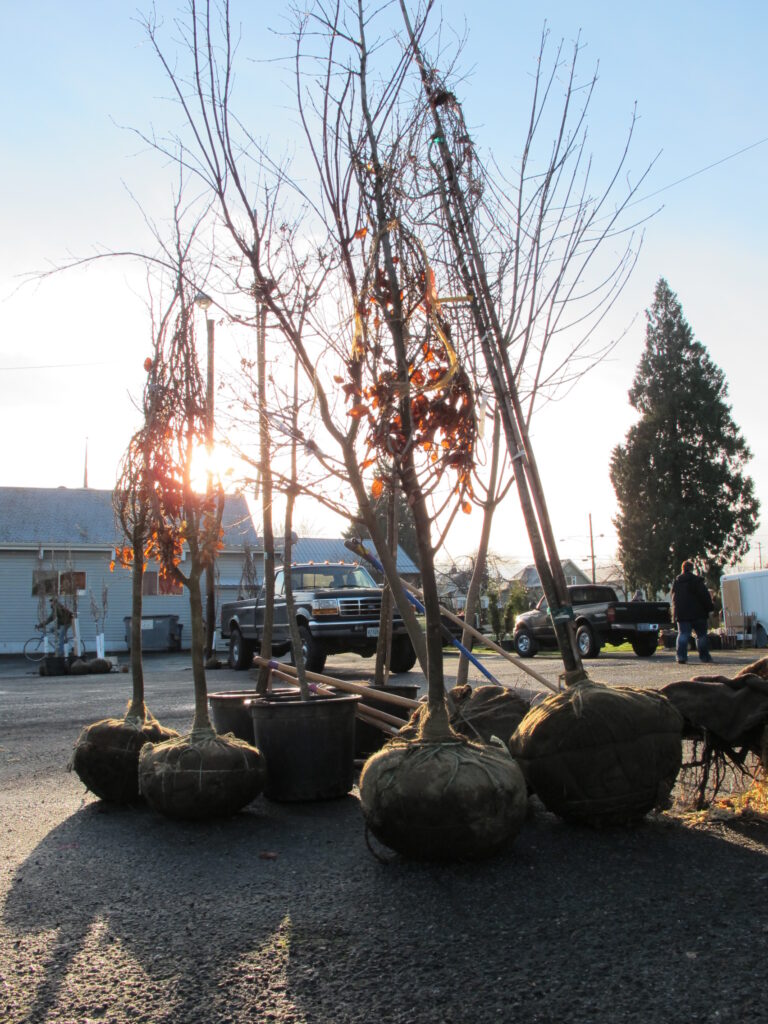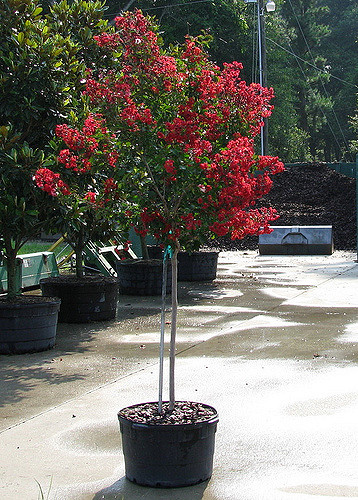Planting a Tree – The Friends of Trees Way
Our goal at Friends of Trees is to make planting a tree easy. If you’re planting a tree on your own, there are a lot of considerations to keep in mind to ensure you are setting your tree up for success. Below are a few tips for choosing where to plant your tree, and how to plant various kinds of root stock!
PLANTING A BALL & BURLAP TREE
PLANTING A CONTAINER TREE

WHAT IS A BALL & BURLAP TREE?
A balled & burlapped (B&B) tree is grown directly ground until it is ready to be transplanted. The nursery digs them up in the fall, wraps and ties them in burlap, and sends them off to their forever homes. There are a few important things to keep in mind when planting a B&B tree!
In the video below, FOT alums Kris Hikari and Susie Peterson show us how to properly plant Ball and Burlap tree stock.

WHAT IS A CONTAINER TREE?
A container tree is just that – a tree that has grown up in a container. While this makes for easy transport, the tree roots may begin to circle when they reach the edge of the pot. Make sure to loosen any circling roots when planting to prevent long term damage!
In the video below, Neighborhood Trees Specialist Haley Miller shows us everything we need to know about planting container stock trees!
Steps to planting a B&B tree:
- Carefully remove any wire basket, and unwrap the tree’s burlap, leaving it underneath the tree. (You will use the unwrapped burlap to lift and move the tree.)
- Gently remove extra soil from around the top of the root ball until you find the root flare of the highest major root. Protect the root ball from falling apart during this process.
- Dig the planting hole the same depth as the root ball but 2-3 times the width. Score the sides of the hole.
- Gently lift the tree using the burlap and lower it into the middle of the hole. The root flare—highest major root—should be level with the soil surface.
- Rock the tree gently to one side while tucking the burlap beneath the tree. Rock the tree gently to the opposite side, enabling you to pull out the burlap from the bottom of the hole. Support the root ball to keep it intact throughout the process.
- Stabilize and straighten the tree with backfill, being careful not to crack or damage the root ball. Double check to ensure the highest major root is even with the soil surface.
- Add the rest of the soil back into the hole, gently pressing down as you go to avoid air pockets, but not so hard as to heavily compact the soil.
- After planting, water the tree thoroughly to settle the soil and remove air pockets.
Steps to planting a container tree:
- Carefully remove the tree from the container. Lay it on its side, use your body weight to loosen the root ball, and pull horizontally to remove the tree.
- Massage the roots and loosen up the root ball soil.
- If any roots are circling, lay the root ball on its side and prune the root at the point where it begins to circle. You may need to use a shovel for larger circling roots and shave down the side of the root ball.
- Gently remove extra soil from around the top of the root ball until you find the root flare of the highest major root.
- Gently lift the tree by the root ball with a partner and lower it into the middle of the hole. The root flare—highest major root—should be level with the soil surface.
- Stabilize and straighten the tree with back fill. Double check to ensure the highest major root is even with the soil surface.
- After planting, water the tree thoroughly.
- If you have mulch, spread it around the base of the tree, keeping it 2-4” away from the trunk.
CHOOSING A PLANTING LOCATION
Planting the right tree in the right place is essential if you want to maximize the benefits of trees, such as reduced utility bills, and avoid future interference with foundations, sidewalks, driveways, and fences. If you’re planting a street tree with Friends of Trees, we’ll have your planting strip inspected, and locations will be marked with white paint on the curb or street. Underground and overhead utilities, street signage and lighting, driveways and other infrastructure will all be taken into account.
If you’re planting a tree in your yard, we won’t be able to inspect your private property. Use the following guidelines to choose the best planting location in your yard.
Think About Size
It’s important to think about the future size of trees at maturity, rather than their size at planting. In narrow, open spaces, plant tall, columnar trees. In wide areas with overhead utility wires, plant smaller, rounder trees. Use the graphic below to help you determine the best placement for your tree based on its size.

Maximize the Benefits of Your Tree
To provide effective shading of your home, trees should be planted within 30 feet of the home. Plant at least two feet from property lines and five feet from driveways. To maximize summer shade, plant on the west side of the house. If you want to plant for warmth in winter, consider planting a windbreak, such as a row of conifers. Remember that roots, branches, and buildings don’t mix.
Site vs. Species
It’s important to pick your site first and species second. For instance, if you have ample space, it doesn’t make sense to plant a small, ornamental tree. Likewise, if you have a narrow space with overhead utilities present, it doesn’t make sense to plant a large conifer.
Environmental Factors
When selecting your yard tree, it’s a good idea to think about factors such as soil, water, and sunlight requirements. Friends of Trees’ website, local nurseries and arborists, books, and online resources are great sources for specific tree and site-related information.

